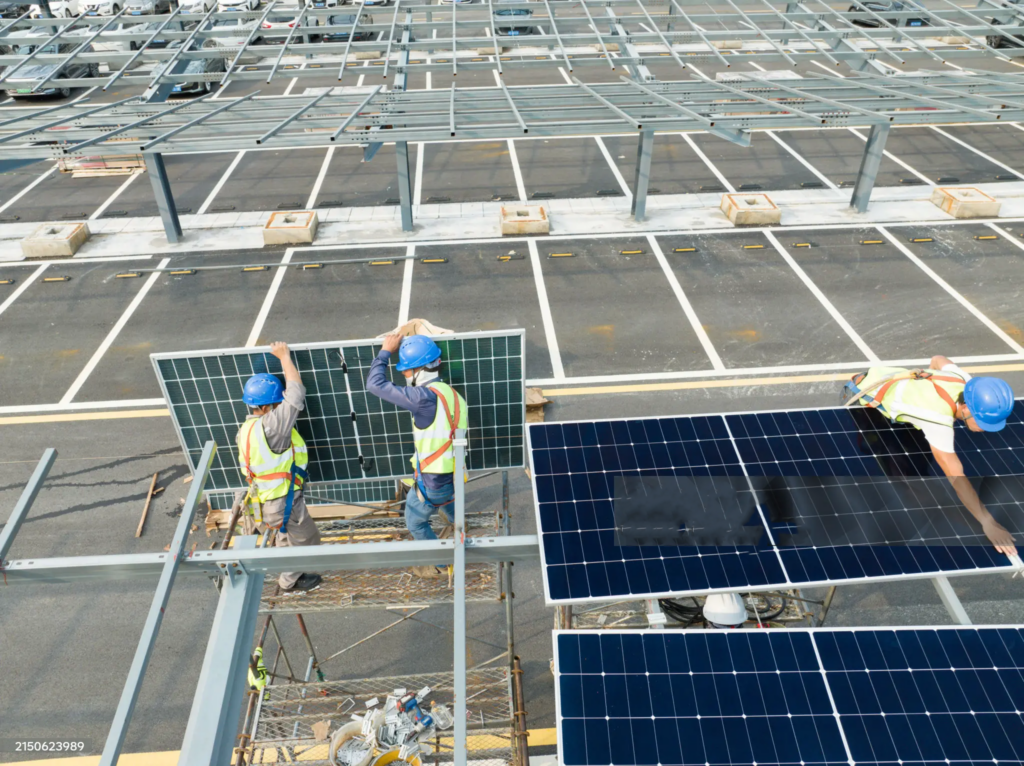With the growing demand for sustainable infrastructure, Building-Integrated Photovoltaics (BIPV) have become a powerful trend in solar architecture.
Among various BIPV applications, the solar carport stands out for its dual functionality—offering both clean power generation and weather protection.
But how exactly do you design and install a BIPV solar carport for commercial or industrial use?
This guide will walk you through the essential steps, from planning and structural design to installation and maintenance.
1. What Is a BIPV Solar Carport?
A BIPV (Building-Integrated Photovoltaic) carport integrates photovoltaic panels directly into the roofing structure instead of mounting them on top of traditional materials.
In other words, the solar panels themselves act as the roof, providing both electricity and shelter.
Key advantages include:
-
Aesthetically clean design
-
High energy efficiency
-
Full waterproof protection
-
Reduced construction cost (no separate roof)
-
Long lifespan and low maintenance
2. Planning Your BIPV Carport Project
Before installation begins, a solid plan is essential.
Here’s what to consider:
Site Assessment
-
Orientation & tilt angle: Ensure panels face south (in the Northern Hemisphere) for optimal solar gain.
-
Shading analysis: Use tools like PVsyst or Helioscope to identify potential shade obstacles.
-
Ground conditions: Verify soil load capacity and drainage for column foundations.
System Sizing
Calculate total electricity demand and available parking area to determine:
-
Installed capacity (kW)
-
Number of BIPV panels
-
Required inverter and wiring capacity
Design Objectives
Decide whether the system will:
-
Power EV chargers
-
Supply building loads
-
Feed into the grid (net metering system)
3. Structural Design and Materials
Frame Material
-
Aluminum alloy: Lightweight, corrosion-resistant, ideal for coastal or humid areas.
-
Galvanized steel: Higher strength for large-scale commercial projects.
Roof Structure
-
Use BIPV glass-glass modules with integrated junction boxes and waterproof connectors.
-
Ensure each panel overlaps with sealing strips (EPDM or silicone) for complete waterproofing.
Foundation Design
-
Choose between concrete footings, ground screws, or pile foundations depending on site conditions.
-
Confirm that all structural elements meet local wind and snow load standards.
4. Electrical Installation Steps
-
Cable Routing
Conceal DC cables within structural channels to prevent exposure and maintain a clean appearance. -
Connection to Inverter
Use waterproof MC4 connectors and ensure proper polarity and grounding. -
Inverter and AC Distribution
Mount the inverter on a sheltered wall or column base, with easy access for maintenance. -
Monitoring System Setup
Integrate an IoT or smart monitoring platform for real-time energy tracking and performance alerts.
⚡ Safety Note:
All electrical work should be performed by certified solar electricians following IEC or UL standards.
5. Waterproofing and Drainage Design
A true BIPV carport must ensure 100% waterproof performance.
Key design considerations include:
-
Overlapping module edges with waterproof sealing
-
Built-in rainwater channels for drainage
-
Slight roof slope (3–10°) to direct water flow
-
Periodic maintenance to clear debris and ensure smooth water discharge
6. Installation Best Practices
-
Conduct a dry run assembly before final tightening
-
Use torque wrenches to ensure uniform bolt fastening
-
Seal all penetration points (cables, junction boxes)
-
Verify insulation resistance and system grounding before grid connection
-
Run a 72-hour waterproof and performance test post-installation
7. Maintenance and Inspection
BIPV carports are low-maintenance, but periodic checks help extend lifespan:
-
Clean glass surfaces every 3–6 months
-
Inspect seals and drainage channels annually
-
Monitor inverter and output regularly
-
Check for corrosion or structural looseness after extreme weather
8. Real-World Example: Commercial BIPV Carport in Europe
A logistics center in Germany installed a 500kW BIPV solar carport using glass-glass modules integrated with aluminum frames.
Results after one year:
-
Annual power generation: 520,000 kWh
-
CO₂ emission reduction: ≈420 tons
-
Fully waterproof, zero leakage after 12 months of rainfall tests
This demonstrates how BIPV carports combine performance, aesthetics, and sustainability in one integrated system.
Conclusion
A well-designed BIPV solar carport can transform parking spaces into high-value renewable energy assets.
By focusing on planning, waterproof design, structural integrity, and electrical safety, you can ensure long-term performance and ROI.
At Top Best Solar, we provide custom BIPV solar carport solutions for commercial and industrial clients worldwide.
👉 Contact us to get free consultation and system design today.







